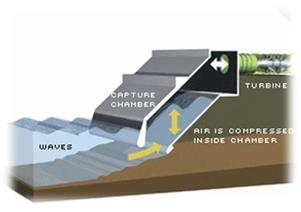

 Among various devices of wave energy converters (WEC), oscillating water column (OWC) devices are one of the concepts successfully deployed around the world. OWC devices consist of an open end box which is immersed partly in the water. The water column inside the chamber has alternative pressure fluctuations due to the incoming incident waves. This internal pressure fluctuation runs the air above the internal free surface inside the enclosed chamber through the turbine, which eventually drives the electrical generator to produce electricity. One of the important advantages of OWC devices is that it is possible to attain much higher frequency of produced electricity than the frequency of waves, which are typically of order 10-1 Hz by using high speed turbines. The OWC devices are considered to be advantageous over the other existing devices as there are no moving parts in the water; the use of an air turbine eliminates the need for gearboxes; no underwater cables are needed for coastal and nearshore devices; they have easy construction and maintenance; there is an efficient usage of the sea space and they are environment friendly.
Among various devices of wave energy converters (WEC), oscillating water column (OWC) devices are one of the concepts successfully deployed around the world. OWC devices consist of an open end box which is immersed partly in the water. The water column inside the chamber has alternative pressure fluctuations due to the incoming incident waves. This internal pressure fluctuation runs the air above the internal free surface inside the enclosed chamber through the turbine, which eventually drives the electrical generator to produce electricity. One of the important advantages of OWC devices is that it is possible to attain much higher frequency of produced electricity than the frequency of waves, which are typically of order 10-1 Hz by using high speed turbines. The OWC devices are considered to be advantageous over the other existing devices as there are no moving parts in the water; the use of an air turbine eliminates the need for gearboxes; no underwater cables are needed for coastal and nearshore devices; they have easy construction and maintenance; there is an efficient usage of the sea space and they are environment friendly.
Hence, the necessity to design and develop the recently devised concept of dual-chamber OWC device attached to an existing costal breakwater emerged. The high performance of this new OWC device leads to significant improvement of the energy production with respect to the conventional types of the device. On the other hand, the attachment of the device to an existing breakwater reduces the wave transmission coefficient of the breakwater and provides safer condition for the structures (e.g. ships) located behind of the breakwater in the sheltered area. Thus, the performance of this combined system is improved with respect to the stand alone conventional types of the breakwaters. It is expected that by incorporating the dual-chamber OWC in an existing breakwater, the structural loads on the supported structure will be also reduced, which would lead to improve strength and reliability of the breakwater structure in survival conditions. Apart from remarked obvious advantages, the economic viability of the combined system is also enhanced significantly as the investment is dedicated simultaneously for two highlighted objectives.